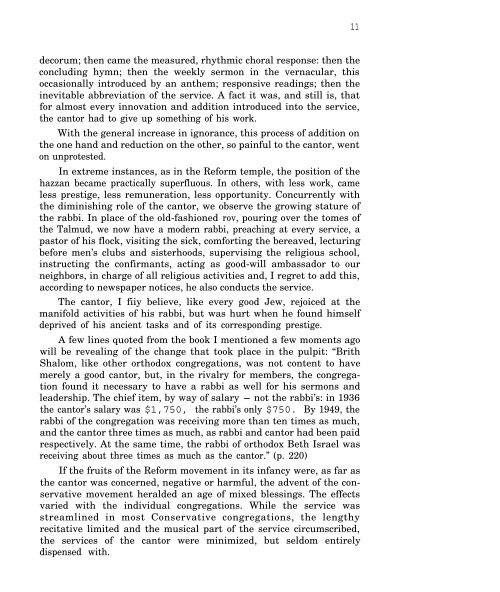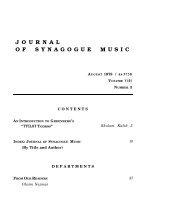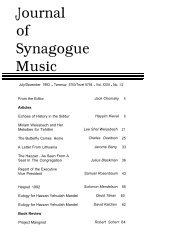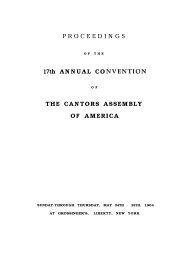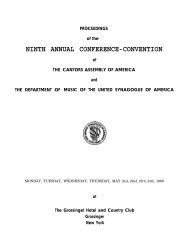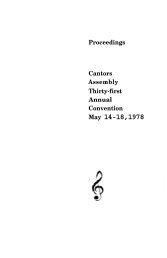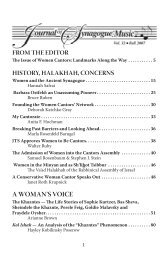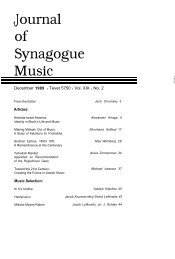Volume 7, Number 3 - Cantors Assembly
Volume 7, Number 3 - Cantors Assembly
Volume 7, Number 3 - Cantors Assembly
You also want an ePaper? Increase the reach of your titles
YUMPU automatically turns print PDFs into web optimized ePapers that Google loves.
decorum; then came the measured, rhythmic choral response: then the<br />
concluding hymn; then the weekly sermon in the vernacular, this<br />
occasionally introduced by an anthem; responsive readings; then the<br />
inevitable abbreviation of the service. A fact it was, and still is, that<br />
for almost every innovation and addition introduced into the service,<br />
the cantor had to give up something of his work.<br />
With the general increase in ignorance, this process of addition on<br />
the one hand and reduction on the other, so painful to the cantor, went<br />
on unprotested.<br />
In extreme instances, as in the Reform temple, the position of the<br />
hazzan became practically superfluous. In others, with less work, came<br />
less prestige, less remuneration, less opportunity. Concurrently with<br />
the diminishing role of the cantor, we observe the growing stature of<br />
the rabbi. In place of the old-fashioned rov, pouring over the tomes of<br />
the Talmud, we now have a modern rabbi, preaching at every service, a<br />
pastor of his flock, visiting the sick, comforting the bereaved, lecturing<br />
before men’s clubs and sisterhoods, supervising the religious school,<br />
instructing the confirmants, acting as good-will ambassador to our<br />
neighbors, in charge of all religious activities and, I regret to add this,<br />
according to newspaper notices, he also conducts the service.<br />
The cantor, I fiiy believe, like every good Jew, rejoiced at the<br />
manifold activities of his rabbi, but was hurt when he found himself<br />
deprived of his ancient tasks and of its corresponding prestige.<br />
A few lines quoted from the book I mentioned a few moments ago<br />
will be revealing of the change that took place in the pulpit: “Brith<br />
Shalom, like other orthodox congregations, was not content to have<br />
merely a good cantor, but, in the rivalry for members, the congregation<br />
found it necessary to have a rabbi as well for his sermons and<br />
leadership. The chief item, by way of salary - not the rabbi’s: in 1936<br />
the cantor’s salary was $1,750, the rabbi’s only $750. By 1949, the<br />
rabbi of the congregation was receiving more than ten times as much,<br />
and the cantor three times as much, as rabbi and cantor had been paid<br />
respectively. At the same time, the rabbi of orthodox Beth Israel was<br />
receiving about three times as much as the cantor.” (p. 220)<br />
If the fruits of the Reform movement in its infancy were, as far as<br />
the cantor was concerned, negative or harmful, the advent of the conservative<br />
movement heralded an age of mixed blessings. The effects<br />
varied with the individual congregations. While the service was<br />
streamlined in most Conservative congregations, the lengthy<br />
recitative limited and the musical part of the service circumscribed,<br />
the services of the cantor were minimized, but seldom entirely<br />
dispensed with.<br />
11


